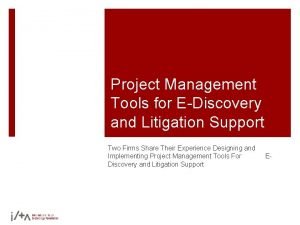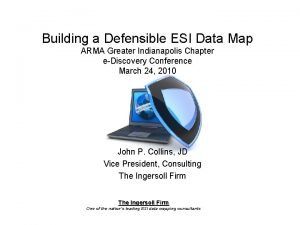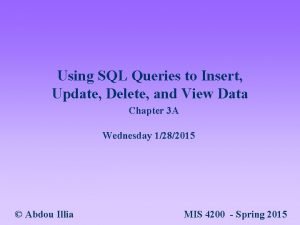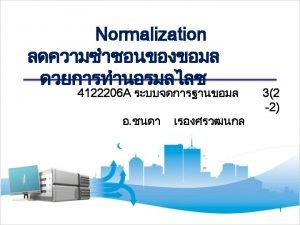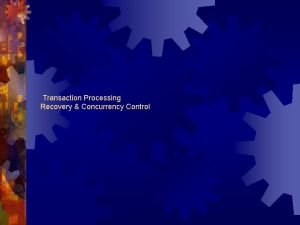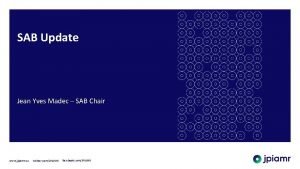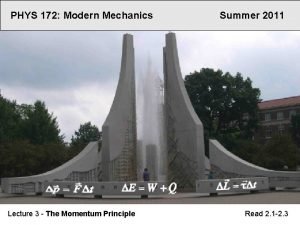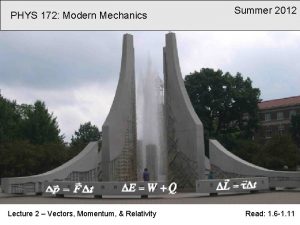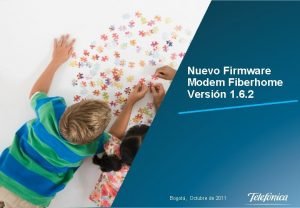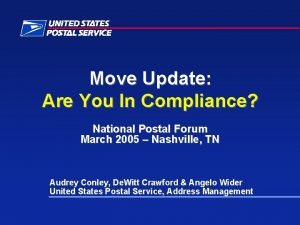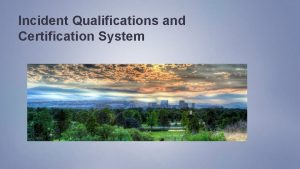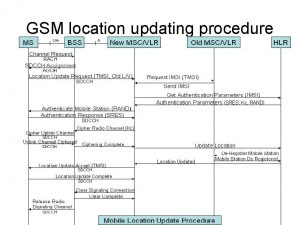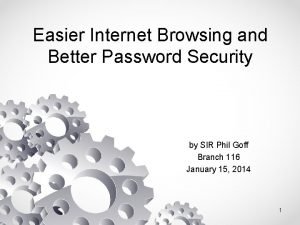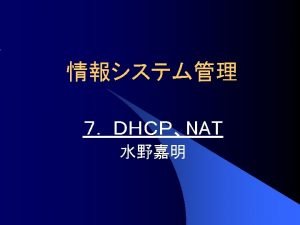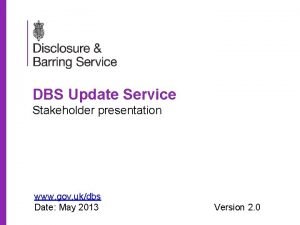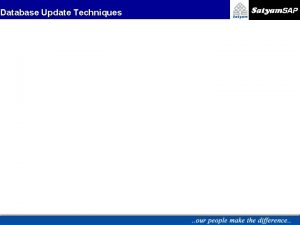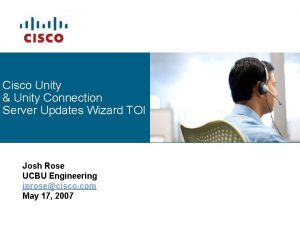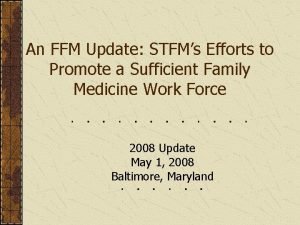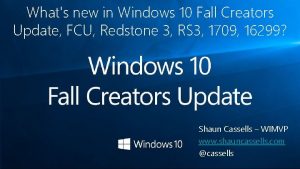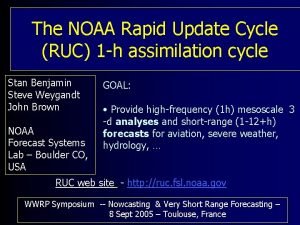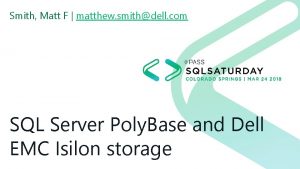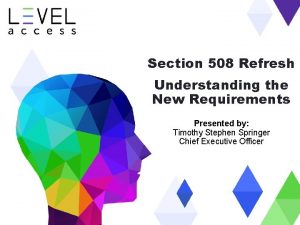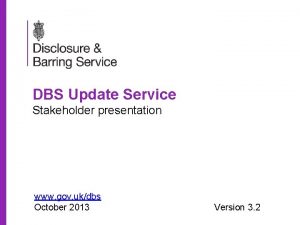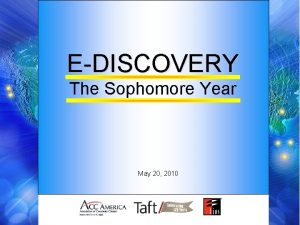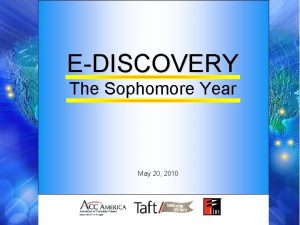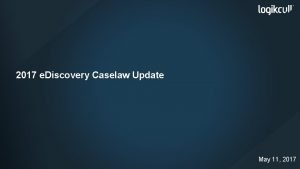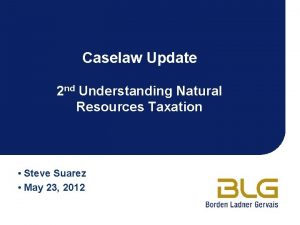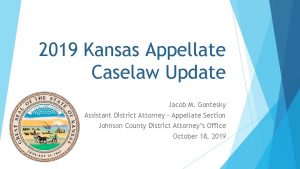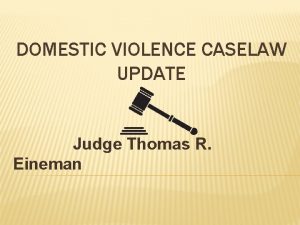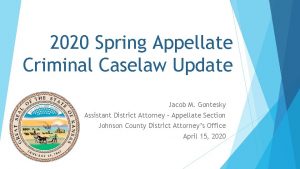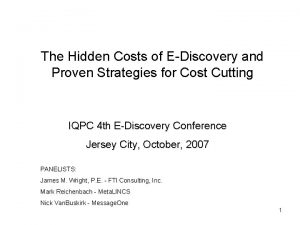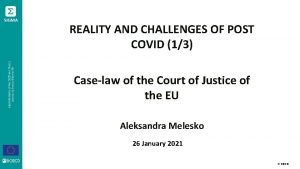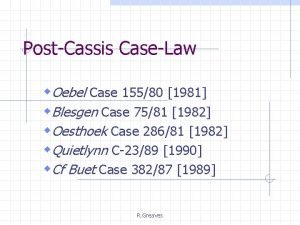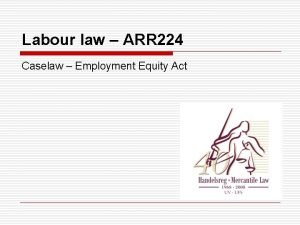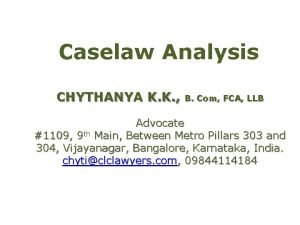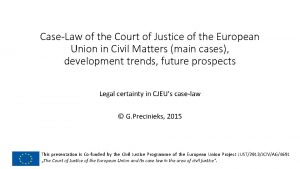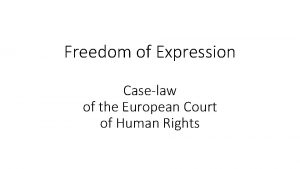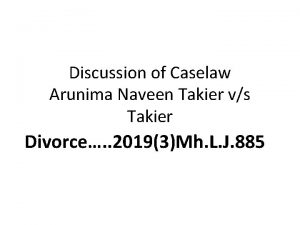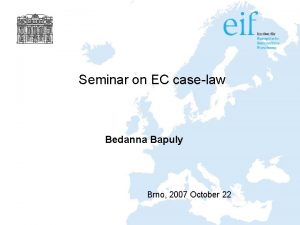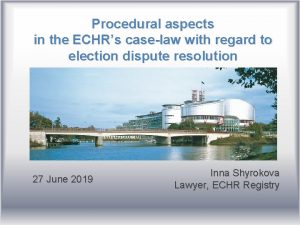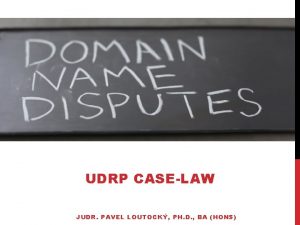Update on EDiscovery Caselaw Issues and CostSaving Strategies















































- Slides: 47

Update on E-Discovery: Caselaw, Issues and Cost-Saving Strategies February 18, 2010

Topics for Today’s Discussion 1. Statistics from Recent Surveys 2. Overview of the Amended Rules of Civil Procedure, Rule of Evidence 502 and Case Trends 3. What Are the Issues? 4. Cost-Saving Strategies 2

Topic 1 – Statistics from Recent Surveys 3

Increase in ESI Productions? – 45% of U. S. companies say the need to produce ESI has increased and will continue to rise – 18% of U. S. companies say the need to produce ESI has increased, but that demand has now peaked and will decline in the next 12 months. – 29% of U. S. companies say demand for ESI has stayed about the same • Kroll Ontrack’s Third Annual ESI Trends Report, August 2009 4

Biggest Challenges Cited by In House Counsel and IT – U. S. in-house counsel rank unmanageable volumes as their number one challenge, whereas IT professionals claim it is lack of time and human resources. • Kroll Ontrack’s Third Annual ESI Trends Report, August 2009 – 24% of U. S. companies say time restraints and expectations are the biggest challenges when legal and IT work together on ESI requests. – A further 23% of U. S. companies cite differences in day-to-day priorities as the biggest challenge. • Kroll Ontrack’s Third Annual ESI Trends Report, August 2009 – 97% of in house counsel surveys said using fewer service providers to do more of the e- discovery process was one of the more important considerations in the selection process. • FTI study quoted in DRI E-Discovery Newsletter 5

Companies are Spending Money on E-Discovery – Average spend on ESI in 2009 is double what it was in 2008. » Kroll Ontrack’s Third Annual ESI Trends Report, August 2009 – Global spending on electronic-discovery software is projected to total more than $1. 2 billion in 2010, and reach a 21. 2 percent compound annual growth from 2008 to 2013. » Gartner, Inc. as cited in DRI E-Discovery Newsletter – The amount of money spent on EDD services and software appears to have dropped by about 9% from 2007 to 2008, according to revenue and expenditure numbers provided by this year's survey participants. – Nonetheless, consumers and providers continue to tell us they expect this market to expand by about 30% throughout 2009 and about 25% in 2010. – Over 600 companies provide some sort of e-discovery services. » 2009 Socha-Gelbmann Electronic Discovery Survey 6

Methods to Reduce E-Discovery Costs – 26% of companies in survey said they are using law firms with specialized e-discovery practices – 24% of companies in survey are outsourcing certain e- discovery functions through preferred provider relationships or master service agreements – 48% of companies in survey are in-sourcing some e- discovery activities » Fulbright’s 6 th Annual Litigation Trends Survey, 2009 7

Topic 2 – Overview of the Amended Rules of Civil Procedure, Pension Committee, Rule of Evidence 502 and Case Trends 8

Recent Sanctions Case – In Pension Committee of the University of Montreal Pension Fund v. Banc of America Securities, 2010 WL 184312 (S. D. N. Y. 2010), U. S. District Court Judge Shira Scheindlin (author of prior five Zubulake decisions) uses tort standards for evaluating conduct of 13 plaintiffs in the discovery context and finds: • 7 plaintiffs acted negligently in their discovery obligations • 6 plaintiffs acted with gross negligence in their discovery obligations • 0 plaintiffs engaged in willful misconduct – Orders spoliation jury instruction against 6 grossly negligent – Awards costs and attorneys fees against all 13 plaintiffs – Orders further discovery of backup media as to 2 plaintiffs 9

Gross Negligent Conduct under Pension Committee – Judge Scheindlin states that the following conduct is grossly negligent after duty to preserve arises: • Failing to issue a written litigation hold • Failing to identify all of the key players and ensure that their ESI and paper records are preserved • Failing to cease deletion of email or to preserve records of former employees that are in a party’s possession, custody or control • Failing to preserve backup tapes when they are the sole source of relevant information or when they relate to key players, if the relevant information maintained by those players is not obtainable from readily accessible sources. 10

Common Problems Criticized in Pension Committee – Preserving only paper documents and failing to preserve ESI – Failing to suspend automatic deletion/purging – Failing to ensure emails were not deleted – Relying on inexperienced employees to lead and conduct search who received no instructions on how to perform search, had no supervision during collection and no contact with counsel during search – Key players searched their own files without supervision from management or counsel – Failure to follow up with employees who were responsible to conduct their own searches – Failure to preserve and collect documents from members of boards of directors or committees – Aware of backup tapes but made no inquiry 11

Common Problems Criticized in Pension Committee – Taking too narrow of a search approach by: • Failing to search for documents on a centralized basis • Failing to search certain personal computers or all servers likely to contain relevant information • Having custodians search own hard drives but not searching company’s servers • Not searching employee’s hard drives after employees performed their own search or otherwise confirming search was complete • Reviewing only subfiles (i. e. folders titled “Lancer”) – Failing to search smartphones, blackberries, palm pilots for relevant information – Collecting documents only “client” understood to be responsive 12

Summary of the Amendments: • Drive early attention to e-discovery issues (e. g. , duty to • 16(b), 26(a), 26(f) preserve) • Adopt a two-tiered approach to discovery based on accessibility of data • 26(b)(2) • Provide a means of addressing assertions of privilege • 26(b)(5) • • • after production Expressly include ESI among materials subject to document requests Allow interrogatories to be answered by ESI Establish procedure for parties to specify form of production of ESI Create a “safe harbor” for routine good faith operation of computer systems Conform subpoena practice to party discovery amendments • 34(a) • 33(d) • 34(b) • 37(f) • 45 13

Fed. R. Evid. 502 – On September 19, 2008, Fed. R. Evid. 502 signed into law – Rule 502 applies to the federal case at issue and to other federal and state cases where the effect of the federal disclosure might be an issue. – Thus, under Rule 502, a state court would not be free to find that a disclosure in a federal case effected a waiver if Rule 502 provides to the contrary. 14

Fed. R. Evid. 502 – Limits Instances of Subject Matter Waiver – Rule 502(a) provides that an intentional waiver in a federal case or to a federal officer generally effectuates a waiver in all state and federal cases • only of the document disclosed, • but can be extended to any undisclosed documents that relate to the same subject matter and that ought in fairness to be considered along with the document disclosed. 15

Fed. R. Evid. 502 – Inadvertent Disclosures: – Rule 502(b) • that inadvertent disclosures in a federal case do NOT effectuate a waiver in the federal case at issue and in other federal and state courts if the disclosure was inadvertent, and reasonable steps to prevent and rectify the disclosure were taken. – Rule 502(c) • that a disclosure in a state case does not effectuate a waiver in a federal case if the disclosure would not have been a waiver if it occurred in federal court, or if it would not result in waiver under state law -- • with the intent that whatever law is more protective against waiver would control. 16

Fed. R. Evid. 502 – Non-Waiver Orders and Agreements – Rule 502(d) gives the court the power to enter orders that determine that disclosures in a federal case will not amount to a waiver in other federal and state courts. – Rule 502(e) provides that agreements to exchange documents without waiver bind only the parties thereto, unless incorporated in a court order. – Taken together, 502(d) and (e) effectively provide that a claw-back or "quick peek" agreement in a federal case is effective in that action and in other federal and state courts if incorporated in a court order. • Agreements only effective only as to the parties if no order is entered. 17

Overview of Case Trends Since December 1, 2006 – E-Discovery cases = approximately 400 (Ken Withers from Sedona has summarized 371 cases since December 1, 2006) • Most prevalent topics: • Preservation lapses/spoliation/sanctions • Right to forensic examination or access to opponent’s computer systems or hard drives • Format of production • Inadvertent production of privileged material/waiver – Cases mostly decided by United States District Court Magistrate Judges – Very few court of appeals decisions to date 18

Topic 3 – What Are the Issues? 19

Preservation and Spoliation Factors: – • Whether party destroyed ESI intentionally or with culpable state of mind • Whether ESI was relevant • Whether the lost ESI is/was available from other sources Remedies: – • Default • Adverse inference instructions • Monetary sanctions • Payment of attorneys’ fees and costs • Gutman, et al. v. Klein, et al. , 2008 WL 4682208 (E. D. N. Y. Oct 15, 2008) (U. S. Magistrate Judge recommended default judgment against the defendants, with attorneys fees and costs, based on evidence indicating that in the days immediately prior to forensic imaging, the defendants had deleted hundreds of files (including files identified on their prior privilege logs], installed a file deletion program, modified the operating system, and tampered with the time clock to obscure the timing of these events; court stated that “in this case, the destruction of evidence was of the worst sort: intentional, thoroughgoing, and (unsuccessfully) concealed”). 20

Preservation and Spoliation Outcome: – • Default: rare • Adverse inference instructions: increasing in frequency • Monetary sanctions: more common • Attorneys’ fees/costs: most common • So. Mech. Servs. , Inc, v. Brody, 2009 WL 2883057 (M. D. Fla. Aug. 31, 2009) (court issued an adverse inference instruction in this computer fraud and abuse litigation based on deliberate wiping of personal e-mails, telephone records, text messages and calendar entries from laptops and Black. Berry smartphones notwithstanding defendant’s argument that all evidence was preserved on the servers and that e-mails were produced in hard copy from the servers) • Conner v. Sun Trust Bank, 546 F. Supp. 2 d 1360 (N. D. Ga. March 5, 2008) (court ordered adverse inference instruction in this Family and Medical Leave Act action based on defendant’s destruction of a relevant email that explained why the plaintiff was fired while on leave rejecting defendant’s argument concerning its 30 -day e-mail destruction policy which automatically deleted e-mails that were thirty days old, unless they were first archived by the user) 21

Requests for Access and Snapshots – Prerequisites: • Computers have special connection to lawsuit • A showing that ESI has been withheld or purged • Systematic abuse of discovery process – Fed. R. Civ. P. 34: • No automatic right to conduct own search • Wishful thinking not enough; no right to double-check • Memry Corporation v. Kentucky Oil Technology, 2007 WL 832937 (N. D. Cal. March 19, 2007) (refusing to grant access to responding party’s computer system because flaws in production, and failing to produce two emails out of thousands do not justify access; requesting party is not entitled to obtain access to determine whether responding party was forthright in discovery; court distinguishes cases where mirror imaging allowed because data was in danger of being destroyed or where computers had special connection to lawsuit) • Ford Motor Co. , et al. v. Edgewood Props. , Inc. , 2009 WL 1416223 (D. N. J. May 19, 2009) (court held that Edgewood not entitled to “confirm the adequacy of Ford’s manual document collection process” by employing a third party to perform key word searches on documents outside of the existing ESI since it failed to make a colorable showing that Ford had purposefully or negligently withheld documents) 22

Examples of Where Courts Seem to Be in Rough Consensus Courts are generally in agreement that a corporation’s backup tapes used for disaster recovery purposes are not reasonably accessible – • • Cache La Poudre Feeds, LLC v. Land O’Lakes, Inc. , 2007 U. S. Dist. LEXIS 15277 (D. Colo. March 2, 2007) (responding party not required to search 400 backup tapes that could contain potentially responsive information because tapes were not reasonably accessible under Rule 26(b)(2)(B)) Forest Labs, Inc. , et al. v. Caraco Pharm. Labs. , Ltd. , et al. , 2009 WL 998402 (E. D. Mich. Apr. 14, 2009) (court held that backup tapes made after 2003 were inaccessible because defendants did not even argue that the backup tapes were used for primary storage or some purpose other than disaster recovery and therefore, plaintiffs' evidence that the tapes were inaccessible stood unrebutted) 23

Examples of Where Courts Seem to Be in Rough Consensus – Courts are generally in agreement that they will not even consider a responding party’s request to shift the costs of collecting and producing ESI during the discovery process until the court makes a finding that the ESI sought is not reasonably accessible • Pipefitters Local No. 636 Pension Fund v. Mercer Human Resource Consulting, Inc. , 2007 U. S. Dist. LEXIS 52169 (E. D. Mich. July 19, 2007) (striking magistrate judge’s order requiring requesting party to pay for restoring ESI because magistrate judge did not engage in proper analysis under Rule 26(b)(2)(B) regarding not reasonably accessible ESI before shifting costs) • Dahl v. Bain Capital Partners LLC, 2009 WL 1748526 (D. Mass. June 22, 2009) (court held there could be no cost shifting without showing of inaccessibility under Rule 26(b)(2)(B) and there were no exceptional circumstances warranting costshifting here) 24

Examples of Where Courts Seem to Be in Rough Consensus – Most courts are not requiring the production of ESI in native format or with metadata intact, absent a particularized need for the ESI, when the request for production did not seek production in these formats • Michigan First Credit Union v. Cumis Ins. Society, Inc. , 2007 U. S. Dist. LEXIS 84842 (E. D. Mich. Nov. 16, 2007) (in case where requesting party did not specify form of production, court clarified prior order to reflect that defendant was not required to produce ESI in native format with metadata intact because it would be extremely burdensome to do so and requesting party failed to show such production would lead to discoverable evidence) 25

Example of Where Courts Are Coming Out at Different Places – Some courts are refusing to require production in native format and/or with metadata in tact even though the request for production specified these formats because there was not a showing of particularized need • – Kay Beer Distributing, Inc. v. Energy Brands, Inc. , 2009 WL 1649592 (E. D. Wis. June 10, 2009) (court refuses to order production in native Outlook format notwithstanding requesting party’s specification in discovery requests because producing in native would be unduly burdensome and excessive and court stated, “unless it is material to resolving the dispute, there is no obligation to preserve and produce metadata absent agreement of the parties or order of the court) Some courts are requiring production in native format and/or with metadata in tact when the request for production specified these formats regardless of showing of particularized need • In re Netbank Sec. Litig. , 2009 WL 2461036 (N. D. Ga. Aug. 7, 2009) (court ordered production of ESI in native format, despite defendants’ objections that such production was not required by the federal rules, allowed for the alteration of documents, and prevented bates labeling, among other reasons, where defendants’ problems were deemed “hypothetical”). 26

Example of Where Courts Are Coming Out at Different Places – Some courts are applying burden-shifting accessibility analysis in Rule 26(b)(2)(B) to resolve a motion to compel ESI • – Parkdale America v. Travelers Casualty and Surety Co. , 2007 U. S. Dist. LEXIS 88820 (W. D. N. C. Nov. 19, 2007) (requiring responding party to produce emails in Lotus Notes format because responding party had not met burden to show emails were not reasonably accessible under Rule 26(b)(2)(B)) Some courts are applying Rule 26(b)(2)(C) without considering or acknowledging the existence of Rule 26(b)(2)(B) • • Heartland Surgical Specialty Hospital v. Midwest Division, Inc. , 2007 U. S. Dist. LEXIS 53217 (D. Kan. July 20, 2007) (declining to require non-parties to conduct searches of personal email accounts after balancing burden of conducting searches against likelihood that few, if any, additional documents would be recovered) Oracle Corp. v. SAP AG, No. C-07 -01658 (N. D. Cal. July 3, 2008) (in case involving alleged unlawful downloading of software which the plaintiff claims damages of “at least a billion dollars, ” discovery of the documents of 165 key custodians will cost the defendant an estimated $16. 5 million and take mare than a year, Magistrate Judge ordered that the number of custodians be limited to 120 and that the parties consider sampling and key word searches to limit the scope of discovery even further based on Rule 26(b)(2)(C) and Rule 1) 27

Issues that Have Emerged as Controversial – A few courts have opined that the use of keywords is “out of favor” and selection of keywords should involve experts; other courts more reasonably require that the search methodology be tested to ensure accuracy • Asarco, Inc. v. U. S. Envtl. Prot. Agency, 2009 WL 1138830 (D. D. C. Apr. 28, 2009) (court granted plaintiff’s request for more search terms when defendant employed only one search term but noting that keyword searches are no longer the “favored methodology”) • Victor Stanley, Inc. v. Creative. Pipe, Inc. , 2008 WL 2221841 (D. Md. May 29, 2008) (court found that the defendants failed to exercise reasonable care in performing keyword search for privileged documents by not conducting sampling of quality assurance; “while keyword searches have long been recognized as appropriate and helpful for ESI search and retrieval, there are well-known limitations and risks associated with them, and proper selection and implementation obviously involves technical, if not scientific knowledge” • United States v. O’Keefe, 2008 WL 449729 (D. D. C. Feb. 18, 2008) (“Given this complexity, for lawyers and judges to dare opine that a certain search term or terms would be more likely to produce information than the terms that were used is truly to go where angels fear to tread. This topic is clearly beyond the ken of a layman and requires that any such conclusion be based on evidence that, for example, meets the criteria of Rule 702 of the Federal Rules of Evidence”) • Williams A. Gross Constr. Assocs. , Inc. v. Am. Mfrs. Mut. Ins. Co. , 256 F. R. D. 134 (S. D. N. Y. Mar. 19, 2009) (court held that parties’ attorneys should cooperate and carefully make the appropriate keyword searches for the nonparty to implement and to produce relevant emails and court also noted that the proposed methodology must be tested to ensure accuracy) 28

Issues that Have Emerged as Controversial – Columbia Pictures Industries v. Justin Bunnell, 2007 WL 2080419 (C. D. Cal. May 29, 2007) • Server log data stored temporarily in RAM constituted ESI under Rule 34(a) • Server log data is reasonably accessible under Rule 26(b)(2)(B) • Server log data should have been retained after duty to preserve was triggered • Court refused to impose sanctions because failure to retain data was based on good faith belief it was not required (Rule 37(f)) • Court required logging function to be turned on to preserve data • Court states holding is not precedent that companies must preserve or produce ESI temporarily stored in RAM for all cases but was required here because it was highly relevant, potentially case-dispositive and no showing of undue burden or cost 29

Top Cases of 2009 According to Sedona – Spieker v. Quest Cherokee, LLC. , 2009 WL 2168892 (D. Kan. July 21, 2009) (court rejected the plaintiffs’ suggestion that the defendant could simply turn its ESI over to them for searching under a Fed. R. Civ. P. 26(b)(5)(B) protective order and Fed. R. Evid. 502(b) nonwaiver order because these orders would still require the defendant to conduct a “reasonable” and allegedly expensive, privilege review beforehand) 30

Top Cases of 2009 According to Sedona – Innis Arden Golf Club v. Pitney Bowes, Inc. , et al. , 2009 U. S. Dist. LEXIS 43588 (D. Conn. May 21, 2009) (based on Innis’ failure to preserve evidence after a duty to do so arose, the inadequate notice regarding the impending destruction of the evidence, and the “significant prejudice” suffered by Pitney, the court determined a sanction of adverse inference did not go far enough and precluded any evidence based on the destroyed soil samples) – Pinstripe Inc. v. Manpower Inc. , 2009 WL 2252131 (N. D. Okla. July 29, 2009) (court sanctions Manpower for failure to implement legal hold by ordering it to pay the cost of any further depositions relating to the failure to implement the hold and pay $2, 500 to the Tulsa Bar Association for the cost of a future seminar on litigation holds but refusing to sanction national counsel or local counsel because they properly drafted the litigation hold and advised Manpower to spend over $30, 000 to recover all lost emails, and believed that Manpower executed those procedures properly) 31

Top Cases of 2009 According to Sedona – Phillip M. Adams & Assoc. , LLC v. Dell, Inc. , et al. , 2009 WL 910801 (D. Utah Mar. 30, 2009) (holding that defendants’ reliance on their employees’ judgment in deciding what to preserve was not an adequate retention policy and holding the spoliation was not the result of a “good faith” or “routine” removal of electronic data) – Grider, et al. v. Keystone Health Plan Central, 2007 U. S. Dist. LEXIS 73066 (E. D. Pa. Sept. 28, 2007) (imposing monetary sanctions totaling $5 million on both the defendants and their counsel in a class action suit against a managed health care plan based on three years of discovery obstruction and last-minute production of paper and ESI that the defendants had previously claimed did not exist), vacated, 2009 U. S. App. LEXIS 19642 (3 rd Cir. 2009) 32

Topic 4 – Cost Saving Strategies 33

E-Discovery Stages Electronic Discovery Reference Model www. edrm. net Processing Preservation Information Management Identification Review Production Presentation Collection Analysis Volume Relevance Source: Socha Consulting and Gelbmann & Associates. Copyright 2005 -2006. All rights reserved. 34

Stage that Costs the Most Electronic Discovery Reference Model www. edrm. net Processing Preservation Information Management Identification Review Production Presentation Collection Analysis Volume Relevance Source: Socha Consulting and Gelbmann & Associates. Copyright 2005 -2006. All rights reserved. 35

Stages to Focus on to Achieve Cost Savings Electronic Discovery Reference Model www. edrm. net Processing Preservation Information Management Identification Review Production Presentation Collection Analysis Volume Relevance Source: Socha Consulting and Gelbmann & Associates. Copyright 2005 -2006. All rights reserved. 36

What is Document Review? – Can involve these steps: • Training of attorney-reviewers on substantive issues in case and review tool technology to be utilized to review electronically stored information (“ESI”) • “First Line” – Attorneys review ESI for privilege, responsiveness, confidentiality and other issues utilizing review tool technology • “Second Line” – Attorneys perform a quality control review of percentage of ESI that was already reviewed by first line and deemed responsive and nonresponsive 37

Why is Review Necessary? – Protect confidentiality of ESI and ensure compliance with protective order – Learn the facts of the case through ESI collected from relevant players in litigation – Organize ESI so that higher billing attorneys spend their time reviewing clearly relevant information – Fulfill discovery obligations under Fed. R. Civ. Pro. 34 to produce responsive, non-privileged ESI – Ensure opponent does not receive non-responsive ESI that is highly sensitive or that can spawn new litigation 38

Why is Review Necessary? (cont. ) – Protect the attorney-client privilege/work product doctrine • Based on the volume of ESI that is created and stored by corporations and then collected, reviewed and produced in litigation, there is a high likelihood that privileged and work product protected ESI will be inadvertently produced. – Under Rule of Evidence 502, there is no waiver “if the disclosure is inadvertent; the holder of the privilege or protection took reasonable steps to prevent disclosure; and the holder promptly took reasonable steps to rectify the error… “ 39

Why is Review Necessary? (cont. ) – Recent instances where courts found reasonable steps were not taken and waiver of attorney-client privilege occurred because diligent review was not conducted prior to production. • Infor. Global Solutions v. St. Paul Fire & Marine Insur. Co. , 2009 U. S. Dist. Lexis 71370 (N. D. Cal. Aug. 3, 2009) (court found waiver of attorney-client privilege where plaintiff that inadvertently produced 227 privileged emails did not conduct internal document review prior to production because of a tight court deadline and plaintiff believed production did not contain privileged materials based on past reviews of previously produced documents. ) • Larry Peterson v. Robert Bernardi, 2009 U. S. Dist. Lexis 64486 (D. N. J. July 24, 2009) (court found waiver of attorney-client privilege where plaintiff who inadvertently produced 135 privileged documents did not sufficiently demonstrate “when his review of documents occurred, what documents were reviewed, and other details of the review process. ”) • Spieker v. Quest Cherokee, LLC. , 2009 WL 2168892 (D. Kan. July 21, 2009) (court rejected the plaintiffs’ suggestion that the defendant could simply turn its ESI over to them for searching under a Fed. R. Civ. P. 26(b)(5)(B) protective order and Fed. R. Evid. 502(b) nonwaiver order because these orders would still require the defendant to conduct a “reasonable” and allegedly expensive, privilege review beforehand) 40

Reasons Review is Expensive – According to KPMG, document review encompasses anywhere between. 58 to. 90 of every dollar spent on litigation – Takes reviewers significant time to review documents for responsiveness and privilege • Depending on the nature and complexity of documents, the tools used to conduct review and other factors, it could take one reviewer 1 day to review anywhere from 400 -1100 documents, or 20 reviewers anywhere from two to four weeks to review 100, 000 documents. – Fees for review for responsiveness and privilege has been historically based on an hourly model in a linear review. The more documents there are to review, the more hours attorneys must spend reviewing documents and billing for those hours, and the more the client pays. – Review for responsiveness and privilege has historically been done by partner- track associates. • If 20 partner track associates are billing for four weeks straight to review 100, 000 documents at $340/hour = $748, 000 41

Reasons Review is Expensive (cont. ) – Overcollection of ESI – Failure to utilize strategies to reduce volume of ESI (keyword searching, deduplication, date limitation, etc. ) – Failure to utilize appropriate technology to perform review 42

Cost Saving Strategies - Decreasing Volume – Keywords – Date filtering – Deduplication across all custodians – Sampling of key players’ email prior to review – Pre-privilege searches 43

Other Opportunities for Cost Savings – Adhere to protocols – Require outside counsel to obtain approval before any processing of ESI is done or review tool is licensed – Review vendor invoices carefully – Timely reporting saves money – Transparency leads to certainty and cost-containment 44

45

46

Questions? – Ronni Dawn Solomon 404. 572. 3457 rsolomon@kslaw. com 47
 Deferred update and immediate update
Deferred update and immediate update Litigation project management
Litigation project management Europe healthcare archiving and ediscovery market outlook
Europe healthcare archiving and ediscovery market outlook Www.texasfailuretoappear.com search
Www.texasfailuretoappear.com search Ediscovery data map
Ediscovery data map Ediscovery unindexed items
Ediscovery unindexed items Chapter 7 strategic management
Chapter 7 strategic management Mis issues in strategy implementation
Mis issues in strategy implementation Chapter 7 strategic management
Chapter 7 strategic management Strategic business unit structure
Strategic business unit structure Implementing strategies management and operations issues
Implementing strategies management and operations issues Basic knowledge of food and beverage
Basic knowledge of food and beverage Sql insert update delete query
Sql insert update delete query Data redundancy and update anomalies
Data redundancy and update anomalies Zechariah stevenson update
Zechariah stevenson update Zechariah stevenson
Zechariah stevenson University community plan
University community plan Temporary update problem in dbms
Temporary update problem in dbms Www sab update com download
Www sab update com download Routing area update
Routing area update Dokumen deskripsi sdmk
Dokumen deskripsi sdmk Gtcs prd examples
Gtcs prd examples Position update formula
Position update formula Position update formula
Position update formula Fiberhome firmware download
Fiberhome firmware download Move update compliance
Move update compliance Mdh situation update
Mdh situation update Iqcs login
Iqcs login Cucm mixed mode with tokenless ctl
Cucm mixed mode with tokenless ctl 811 locate request
811 locate request Gsm location update procedure
Gsm location update procedure Chrome update
Chrome update Ocean freight market update dhl
Ocean freight market update dhl Ddns-update-style none
Ddns-update-style none Www.gov.ukdbs-update-service
Www.gov.ukdbs-update-service Non-updating function module called for updating
Non-updating function module called for updating Unity connection to the update server failed
Unity connection to the update server failed Bankhead primary school
Bankhead primary school Bankhead primary rutherglen
Bankhead primary rutherglen Ffm update
Ffm update Language windows 10
Language windows 10 Adobe connect update
Adobe connect update Replace
Replace Download oracle jre 7 update 51 (64-bit) for polybase
Download oracle jre 7 update 51 (64-bit) for polybase Section 508 update
Section 508 update Project status examples
Project status examples Update raksha tpa contact details
Update raksha tpa contact details Www.gov.ukdbs
Www.gov.ukdbs

